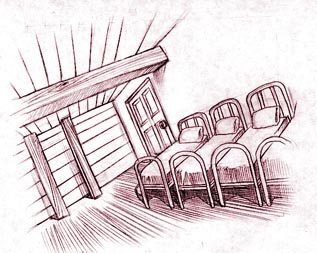For Ottawa, in Indian education as in so many other areas involving the First Peoples of Canada, the bottom line was the bottom line. The $44,000 found in 1883 to finance the first three western industrial schools was located in part by trimming expenditure on Indians by some $140,000, thereby contributing to the hardship that prairie Indians recently bereft of the buffalo were experiencing.
The same concern for frugality marched in step with the expansion of the residential school system after 1883. By 1888 the cabinet had authorized the reduction of salaries at the initial three industrial schools in the west, which had been financed relatively generously, as staff changes and other circumstances permitted.
The rudimentary dormitory in the basement of Ermineskin school at Hobbema in 1938
Indian Commissioner Hayter Reed forced a crackdown on the number of parents visiting their students at the Qu'Appelle school, as much because of the expense of feeding them as to prevent their removing students from the institution. In a stern conversation with Principal Hugonnard, Reed 'told him that the Government expected a much greater return for the large expenditure in connection with these Institutions, than was being obtained.'



